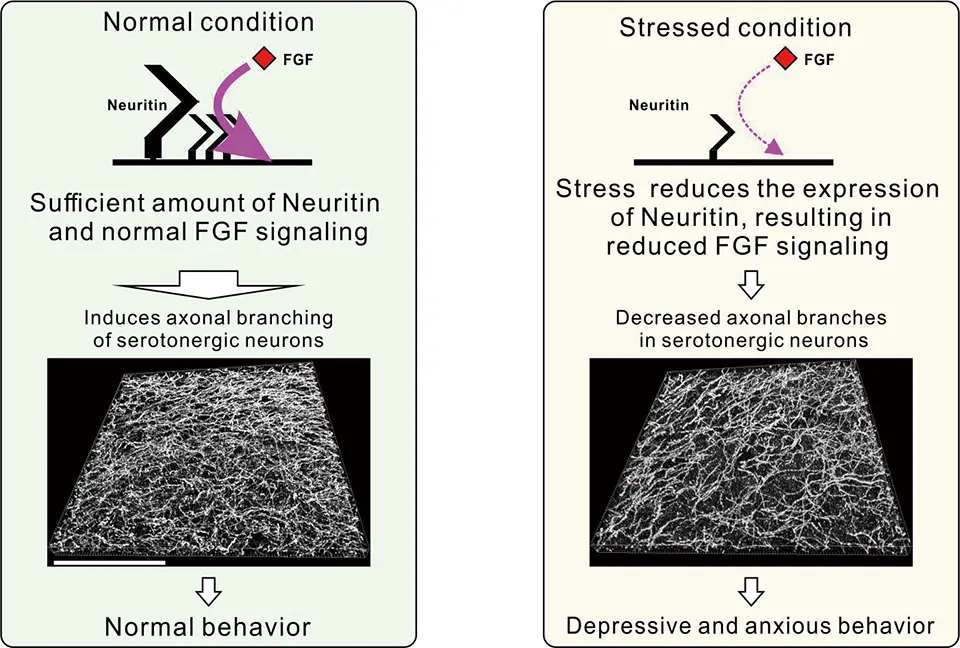Meet our scientists!
 Back
Back
Anxiety and depression affect hundreds of millions of people worldwide, and these numbers increased significantly during the covid pandemic. Anxiety and depression are associated with stress, and decreased branching and complexity of neurons in various brain regions. However, the precise molecular pathways causing these disorders are not known. Takayuki Shimada and colleagues in the Child Brain Project at TMIMS recently elucidated a novel pathway through which stress induces these disorders and published this work in the October 9th, 2024 issue of the Journal of Neuroscience (44(41):e0129232024). They determined that stress reduces expression of an extracellular signaling molecule, neuritin. Neuritin, stabilizes the cell surface expression of the fibroblast growth factor (FGF) receptor, and FGF signaling controls axonal branching of serotonergic neurons in several brain regions. Thus, decreases in neuritin expression cause reductions in axonal branching of serotonergic neurons resulting in anxiety and depression. This work clarifies our understanding of the causes of anxiety and depressive disorders and paves the way for the development of new treatments. We spoke to Dr. Shimada about this work and his interest in science.

How did you first become interested in science and research?
In high school, I remember learning about past scientists. I was very impressed when I learned about scientists such as Watson and Crick who discovered the structure of DNA, or Frederick Griffith, who used Pneumonia to suggest that bacteria are capable of transferring genetic information. These scientists discovered things that were not known before, and I decided that I, too, wanted to discover new things.
When did you become interested in studying depression and anxiety?
I wanted to know what causes cells to develop into different shapes. For example, neurons start out round, but then they extend processes that become dendrites and axons that are specialized in transmitting electrical signals. Neurons can extend axons that originate in the brain and extend all the way to the hips or intestines! I’m interested in understanding the mechanisms that control the extension, branching, and connections that these axons make. Since cell shape and branching are so important for cell function, I thought that there must be diseases that are caused by defects in cell shape. In this case, it turned out that the diseases resulting from defects in axonal branching are depression and anxiety.
So, your current findings are that changes in the shape of serotonergic neurons can cause anxiety and depression?
Yes, I think changes to the shape of serotonergic neurons contribute to these diseases. Most people think that anxiety and depression are caused simply by decreases in the amount of serotonin. If that’s the case, increasing amounts of serotonin should quickly cure these diseases.
But that’s not the case. SSRIs (selective serotonin reuptake inhibitors), drugs used to treat these diseases, increase amounts of serotonin quickly, but they take a long time to relieve disease symptoms. People have been focusing on understanding pathways downstream of serotonin, but I believe it’s necessary to study the structure of serotonergic neurons and the release of serotonin itself. In our paper, we show that stress causes changes to the structure and branching of serotonergic neurons. Axons branch less and become less complex. So, I think less serotonin will be released, but it will be also released in fewer places. SSRIs may increase serotonin signaling in places where serotonin is still present, but they may not be optimal for restoring serotonin release to appropriate locations.
Please tell us the model you developed in your paper.
We found that a protein, neuritin, is important in depression and anxiety disorders. When we knocked out neuritin in mice, we found that these mice have less axonal branching in their serotonergic neurons and develop anxiety and depression symptoms. Conversely, we found that adding neuritin to cultured serotonergic neurons causes them to increase axonal branching. Chronic stress is known to cause depression and anxiety and we found that it decreases neuritin expression and decreases axonal branching of serotonergic neurons. From these results, we hypothesized that stress decreases neuritin expression, which in turn decreases serotonergic branching, causing depression and anxiety. If that is the case, we thought that overexpressing neuritin may protect mice from depression. And that turned out to be true. When we overexpressed neuritin in a brain region known as amygdala, we found that these mice became more resistant to depression caused by stress. They were also resistant to stress-induced decreases in serotonergic axonal branching.
How do you think neuritin controls axonal branching?
We found that neuritin affects the fibroblast growth factor (FGF) signaling pathway. The FGF signaling pathway is a well-known cellular pathway that affects many cellular processes including proliferation, regionnd survival. But, we’ve found that, besides its other well-characterized functions, FGF signaling is also important for axonal branching of serotonergic neurons. In particular, we’ve found that FGF-2 needs to bind to FGF receptor 1 on serotonergic neurons to promote axonal branching. We believe that neuritin binds to FGF receptor 1 and stabilizes its presence on the cell surface so that FGF-2 can bind to it to induce axonal branching. Consistent with this idea, we’ve found that inhibiting FGF signaling causes poor axonal branching of serotonergic neurons and leads to the development of depressive and anxiety behaviors.
Do you think increasing FGF signaling may be a way to combat depression?
FGF signaling is involved in many pathways including cellular growth so I’d be concerned that indiscriminately increasing FGF signaling may induce cancers. Indeed, FGF inhibitors are used in anti-cancer therapies. However, a recent study showed that injection of FGF-2 into rat brains increased resistance to stress-induced depression. Therefore, I think that focusing on increasing neuritin or FGF in specific brain regions may be a better approach.
What are your future interests?
So far, we’ve found that alterations in axons are involved in diseases such as epilepsy, depression, and anxiety. I think there must be many other diseases that result from altered cell structures. So, I’d like to continue my work on studying the relationship between neuronal structures and diseases. In particular, I think that altered axonal structures must be present in developmental disorders including autism and intellectual disorders. I’d like to elucidate the mechanisms involved in those diseases.

(Right panel) Chronic stress decreases the expression of neuritin, resulting in impaired FGF signaling and decreased axonal branching of serotonergic neurons. This leads to the development of depressive and anxiety behaviors. Representative images of axons of serotonergic neurons in mouse amygdala are shown in both panels.
Interviewed by Jun Horiuch